It’s winter in Colorado. No, I mean winter! The temperature here this morning was –12.2F (–25.5C). The high today was 10.7F (–11.8C). This weekend, then, was perfect for the Ouray Ice Festival, held each year at what is likely the premier ice park in the world — at the very least the best public park of its kind, the Ouray Ice Park.
(The weather data at my house really is at my house: I apparently have the only web-accessible weather station in Ouray County. Expect to see some pretty extreme conditions there over the next few days — and especially nights!) [Link removed, no longer online]
This year’s Ice Fest was the 12th annual event, and it was fantastic. I was well suited up against the cold and snapping pictures of the climbers (there are several safe places to look down into the gorge from directly above so you can see things; see photo below). Climbing what? Ice! Frozen waterfalls. Challenging? You bet.
But Not for the Timid
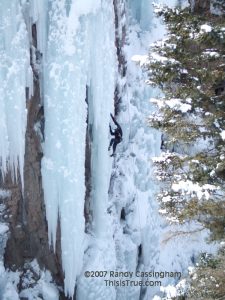
Is ice climbing dangerous? You’re darned right! I hadn’t been there for 20 minutes when my pager went off — the Ouray ambulance was being dispatched to the Ice Park for an injured climber. I hiked up to the staging point to offer a hand.
They didn’t really need me: in addition to the well-staffed ambulance crew, the Ouray Mountain Rescue Team has members on scene during the entire festival. “But hey: you have a camera?! Would you pop over to where we’re bringing her up to get some shots of our new technique?” You bet! I only had my little Fuji digital snapshot camera, but for its size it takes great photos.
The gal had been hit in the head by falling ice. Luckily, one of the hard rules in the ice park is that helmets are required not just during any climbs, but anytime a climber is in the gorge. She was no fool: she was wearing hers, and her helmet broke so her head didn’t have to.
Still, being hit on the head that hard can cause significant internal injuries ranging from concussion to spinal cord damage, so they hauled her out in a basket and took her in for a check, as well as to stitch up the gash on her forehead. As they loaded her in, they decided they’d like to have another female on board, and my wife was standing there. Like me, Kit has just finished up her EMT class work, so she jumped aboard.
Happily, the victim was not seriously injured, and only one other climber received an injury during the event, and that one was minor too.
And if this all sounds (and looks!) really interesting, there’s just one thing better: come yourself next year! Bring warm clothes.
(Scroll down for more photos. You can click all to see them larger.)
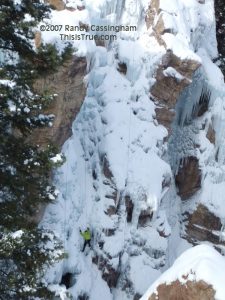
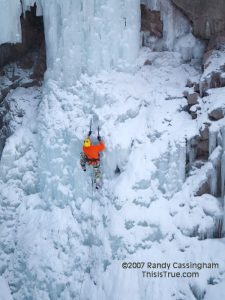
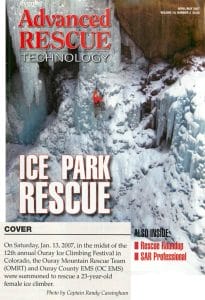
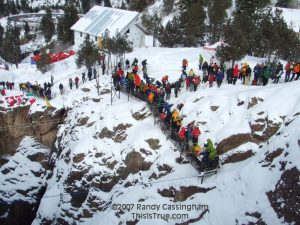
Now to the Rescue of the Injured Climber
Again, you can click the photos to see them larger.
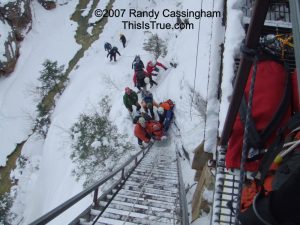
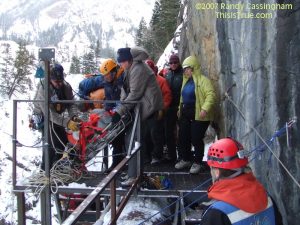
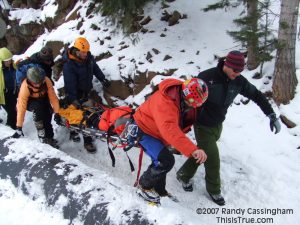
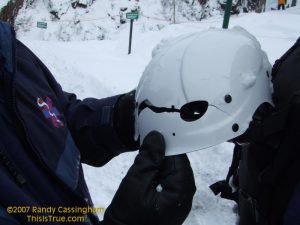
Related Page
I later had the privilege to be the Incident Commander at another OMRT rescue, which is also described in this blog.
– – –
Bad link? Broken image? Other problem on this page? Use the Help button lower right, and thanks.
This page is an example of my style of “Thought-Provoking Entertainment”. This is True is an email newsletter that uses “weird news” as a vehicle to explore the human condition in an entertaining way. If that sounds good, click here to open a subscribe form.
To really support This is True, you’re invited to sign up for a subscription to the much-expanded “Premium” edition:
Q: Why would I want to pay more than the minimum rate?
A: To support the publication to help it thrive and stay online: this kind of support means less future need for price increases (and smaller increases when they do happen), which enables more people to upgrade. This option was requested by existing Premium subscribers.

Fabulous pictues, I loved seeing them. Have to say though, no force on earth could get me to try this! *shudder*
—
We have climbers come here every winter from all over the world. Even Canada! 🙂 -rc
Wow! These are amazing pictures!!! On another note, I think Colorado sent the winter weather to us here in Texas. I’m in West Texas, and we rarely get below 50 here, and today, we actually were hovering around zero to 25 all day! There’s ice on everything – my 12 year old son said, “I’ve never seen so much ice in my life!”
He hasn’t either – it doesn’t get that cold here, ever! (till now!)
Great pictures! I also looked at your weather station … and that is why I like California, where we think freezing starts at maybe 45 and rarely makes 32. Those waterfalls are stunning, though.
Fantastic pictures! Is there anyplace there, where non-ice-climbing folk can watch this event, because it surely would be spectacular.
The only thing I’d rather not have, is that kind of temperature, even if farmers here would like it, so their winter-crops’d not yet grow and the ice-wine can be finished…
—
Yes, as noted there are plenty of safe places to watch the climbing, including two bridges and platforms on the cliff top above. -rc
Thanks for the pictures, they assured me that this is a very extreme sport. Not my cup of tea, but kudos to the brave souls who master this wall of ice.
Yeah, EMS!!!
It is photos like this that make the Outside community take notice of the dedication of the nations Paid and Volunteer EMS.
As dangerous as this looked, I am totally aware that the more routine calls are just as hazardous. If not more.
This just was more fun.
It’s not been any warmer on this side of the mountains (I’m over in Westminster, northern suburb of Denver). This is the longest I’ve seen snow stick around in many years.
It’s not the same thing, but I’d recommend visiting Breckenridge for the Ice Sculpting festival. Those folks that do the carving do some marvelous work. You can find more info here – note that I have no connection with the festival except as an amazed viewer.
So who is the guy carrying the strecher without a Helmet? He must have missed the memo.
—
He’s a topside-based rescue guy. Since he was not in the gorge nor climbing, there’s nothing above him — and a helmet isn’t needed. Spectators don’t need them either; the shot, as noted, is on top of the cliff. -rc
You would think that the “permanent rescue platform and ladder” would serve as a warning — not a challenge! — to these climbers!!!
Nope, you won’t see me there. Growing up in Los Angeles was daring enough for my lifetime. 😉
On a technical side, did you have any issues using that point & shoot in the colder weather? I note it, like mine, claims a lower operating temperature of 32F, which has kept me from taking some outside pictures myself…
—
As I recall, it was in the range of 15-20F. I was definitely keeping the chill in mind, and wondering about the effect on the camera (a tiny Fuji), but it didn’t seem to be bothered. Between shots I kept it in my coat pocket in an attempt to shield it from the cold, but I didn’t go so far as to, say, keep it in my shirt pocket, where it would be actively warmed (in part because I thought the back-and-forth transition between very cold and much warmer might not be A Good Thing)…. -rc
For what it’s worth, the pro photographers filming the Iditarod race learn to leave their cameras outside to avoid condensation, except for one “inside” snapshot camera snuggled under their coat.
Boy, do I feel for you people. When it gets down to 30 degrees here I want to stay in. There are more days over 60 here in the winter than under 30. We almost never see snow.
These photos are amazing Randy. Thank you for sharing them with us.
It’s 39 degrees celcius (102.2 farenheit) in Oz at the moment and has been that hot for 6 days so the cold landscape is a refreshing change. After seeing your photos my husband picked up his Xbox360 control and announced fighting onscreen monsters was as exciting as he wanted his life to be. Adrenalin junkies fascinate me.
Hi Randy – I liked the spread on the Ice Festival. I’m a rock climber hear in the UK.
The reason the climber has the rope BELOW him is that he is being belayed by a climber below him (ie. protected by a rope attached to another climber on the ground). He is what is called “leading” this climb – a normal technique in rock/ice climbing.
If you look to the left of his right foot you will see that he has placed a Ice Screw and runner into the ice. The rope from the person on the ground passes thru this (and previous) runners and is then attached to his harness – should he fall he will be “protected” by being suspended from this ice screw and runner (plus his hopefully heavier mate below!).
In the photo where they are hauling the injured climber along the top the climber with the red jacket is running a significant risk of his helmet failing structually as he has numerous “stickers” attached to it – the solvents in the adhesive are known to chemically attack the plastic and causing it to fracture on impact.
—
I do know what the climber was doing, but didn’t want to bother explaining it. But I didn’t know that about stickers — I’ll google some literature and pass it on. Thanks! -rc
This is the Internet at its best. Just occasionally a little gem like your reference to the Ouray Ice Festival pops up. Seeing such a natural spectacle, the climbers challenging nature, the interest of the spectators and the willing help of the rescue team just bought a smile to my soul.
(Camera geek time: did you have any exposure compensation set?)
—
No; it did just fine adjusting its own exposure to the brightness of the scene, probably in part thanks to the overcast flattening out the light. But I did brighten up the exposures for posting, since the gorge was shadowed. -rc
NOW I remember why I moved away from Colorado years ago! I do NOT miss all that cold weather – not a bit! Actually, we are finally having a bit of a cooler spell, as it will only get up to the high 70’s today and at 9:15 in the morning it is already 68 degrees… paradise for now…. but maybe I’ll go visit my mom in Denver when hurricane season starts!
Great photos. I actually thought that the first photo was faked by turning it ninety degrees, it’s so vertical. I’m glad I don’t do EMS in that weather and our ice rescues are horizontal on the pond.
I’m currently anxiously waiting for a renewal of my EMT as it ran out while working on my Masters. I can’t believe that I actually miss getting up from a sound sleep to help somebody, but after fifteen years it grew on me, and even led to that degree. Keep that camera handy, some of our ER doctors like to see the mechanism of injury, and, since we are half an hour from the hospital, they often have the photo before the patient.
—
Ouray is about an hour from the hospital. When in town we do have cell coverage, but there are plenty of dead spots on the way to the hospital. Maybe someday, though, we’ll be able to transmit photos! -rc
I rarely click on the links in my This is True newsletter. (Dial-up is too slow, but it is all I can afford.) This time I luckily took a gamble. WOW!!! Phenomenal Photography! But, as I have a pathological fear of heights, your pictures scared the h-e-c-k out of me! Hope you passed all your EMT tests and all. Keep up the good work. Thanks for all you do!
Extraordinary. In that first picture, aside from the white bubble of his helmet, the climber looks for all the world like a four-legged spider. And in the third picture — I suppose the reason the climber doesn’t have a rope above him is that he’s supposed to make his way up the ice under his own steam, as it were. But why does he have a rope trailing below him? What’s the purpose of that?
—
Safety. It’s anchored near him, and if he falls it will catch him. -rc
Thanks a bazillion for posting the pics of the OIF. I’m a rock and ice climber and mountaineer (and a Mountain Rescue Association member) myself up here in Washington, and have always wanted to compete down there. Sadly, familial obligations and the passage of time have forced me into spectator status for such competitions. While I can occasionally get out to swing a tool or two, these shenanigans are best left for the youngsters. Some young friends of ours from up here placed very well at the OIF this year, and we’re quite proud of them. Oh, just wanted to say I love This Is True!
Fantastic photos.
One question from the other side of the world: the description of the casualty as ‘the victim’ interests me. Is this usual terminology for casualties of accidents, natural disasters or similar events in your area?
I ask not from a judgemental point of view but purely from interest in the different use of language. Please don’t think I’m being pedantic or overly critical; I’m not. I’m just a student of linguistics and can’t help myself when I see an interesting usage.
—
No worries, mate. Yes, “casualty” is very rare here — and is mostly used in the sense of “casualties of war”. It’s probably for that reason that people involved in accidents are typically called “victims” in the U.S. -rc
I forget where this quote comes from: “Ice climbing is enjoyable only in retrospect.”
I used to rock climb until a bad knee stopped me. Ice climbing always seemed *just a bit* over the line. Ice screws never seemed to me to be as strong as rock anchors.
I had heard the bit about stickers on plastic helmets. Sounds like one for the Mythbusters!!
Loved the photos, quick question on one of them. I looked at the photo where you notated the rope the guy is climbing with is below him, no rope above. Since I have no experience with snow/ice, can you tell me why he is not anchoring something above him in case he falls??? Is there something I am not seeing in the photo that is securing him? Thanks
—
It’s discussed in a prior comment or two, actually: he’s pioneering a path, and he adds and clips into anchors along the way. If he falls, the upper-most anchor stops the fall. -rc